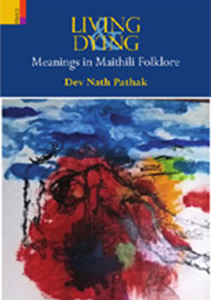
INFORMATION
- AUTHOR : Dev Nath Pathak
- HB ISBN : 978-93-5290-215-6
- Year : 2018
- Extent : 258 pp.
- Discount available on checkout
- Usually dispatched within 3 to 5 working days.
Tagore
| HB ₹ 995 . $ . ₤ |
PB ₹ . $ . ₤ |
|
| POD ₹ . $ . ₤ |
e-Book ₹ . $ . ₤ |
INFORMATION
- AUTHOR –
- ISBN – 978-93-84082-78-9
- Year – 2016
- Extent: 400 + 40 coloured illustrations
- 10% discount + free shipping
- Usually dispatched within 3 to 5 working days.
A hermeneutic engagement with Maithili folk songs allows this book to hinge upon the notions of living and dying in the contemporary world despite the admission that medicine, insurance, market, and media may condition human experiences. Amidst the binaries of union and separation, rigid religion and fluid faith, popular and folk, modernity and tradition, central to this book is the pluralism of cultural script(s) and their philosophical musings on living and dying, folk philosophy, cultural subversion as well as reconciliation. Predominantly sung by women, the folksongs of Mithila are woven around calendar of events, rites of the passage, and everyday life situations. The cultural scape of sound and sight thus conjures a fusion of epistemology and ontology, knowledge and existential being, the classical Sanskritic-textual and the folk subaltern-oral. Straddling the particular context of Maithili folksongs and the generic aspects of folk world view, steering across Hinduism, tradition and modernity, and folklore in the age of mechanical reproduction, this book contributes to the sociology and social anthropology of, inter alia, folklore, religion, gender and mythology. Moreover, this makes for a contribution into sociology and social anthropology of death in South Asia.
The Author
Dev Nath Pathak teaches Sociology at the South Asian University, New Delhi. His current research interest focuses on the popular and performative cultural politics in South Asia. His publications include Intersections in Sociology, Art and Art History: A Conversation with Parul Dave-Mukherji (2016) and Performative Communication: Cultural Politics in South Asia (forthcoming). He is reviews editor of Society and Culture in South Asia, journal of Department of Sociology, South Asian University.
As a global figure, Tagore transcends the boundaries of language and reaches out to people distant both in time and space. His art took inspiration from contemporary Western trends and became a powerful means to connect with people beyond Bengal. Word, image, song, and text were his tools of communication, as also his extraordinary presence in a sartorial garb of his own design. A littérateur in many genres, the impact of his work was determined both by the material he presented, and by its simultaneously local and global contexts. Now, when his international reputation has spanned over more than a hundred years, it is important to revisit the sites of Tagore’s eminence, and ask to what extent he was a ‘living text’ in the century that witnessed him as a global intellectual.
Accordingly, this volume investigates how Tagore’s writings and art are linked to the metalinguistic domains of the psychological, medical and mythical; how he was received in various cultures outside India; how his art was determined by individual circumstances and global aspirations; and how he acted as an inspiration to his contemporaries and subsequent generations including modern Indian writers and artists.
The Editor
Imre Bangha studied in Budapest and Santiniketan and at present is Associate Professor of Hindi at the University of Oxford. He has published books and essays in English, Hindi, and Hungarian on literature in Brajbhasha and other forms of old Hindi and has also prepared Hungarian translations from various South Asian languages. His work on the international reception of Bengali culture includes Rabindranath Tagore: Hundred Years of Global Reception (2014, co-edited with M. Kämpchen) and Hungry Tiger: Encounter between India and Central Europe (2007).
Table Of Contents
| Preface | Vii-Xii |
| Acknowledgements | Xiii-Xv |
| 1 Introduction: A Brief Outline Of The Context Of Quest | 1-24 |
| 2 Living And Dying In The Age Of Plural Cultural Scripts | 25-42 |
| 3 Discursive Framework: Probing Folk And Seeking Lore In The Time Of Polyphony | 43-65 |
| 4 Methodology Of Being: Ruminations On The Field-Hermeneutics | 66-97 |
| 5 Mithila, Maithili And Maithil: Field In Historical Context | 98-130 |
| 6 In Fulhara: Sound And Sight In A World View (Part I) | 131-152 |
| 7 In Fulhara: Sound And Sight In A World View (Part Ii) | 153-193 |
| 8 Art Of Dying In The Maithil Folk Philosophy | 194-214 |
| 9 Conclusion: Text, Subtexts, Inter Alia! | 215-228 |
| Bibliography | 229-238 |
| Index | 239-243 |




